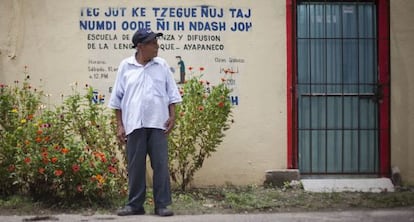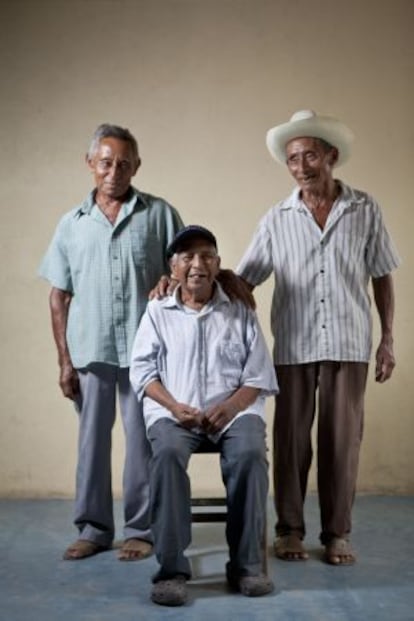The race to save Mexico’s dying languages
The country’s wealth of 68 indigenous tongues is almost unmatched anywhere else

When Fidel Hernández goes back to his home village of Chicahuatxla, the houses suddenly sprout mouths, eyes and backs. There is nothing odd about this. It happens automatically every time the bus emerges out of the Mexico City sprawl and heads down south to his native state of Oaxaca.
At this point Fidel, a PhD student at UNAM, the National Autonomous University of Mexico, leaves behind the doors, windows and ceilings of the Spanish language and steps into the universe of Triqui, a tonal language of which there are 25,883 speakers, according to the official count.
Triqui is part of what might be Mexico’s greatest yet least-known treasure: its linguistic diversity. The country is home to 11 linguistic families that branch out into 68 languages, which in turn have 364 dialects. Such a profusion of tongues is to be found nowhere else in the world save for Papua New Guinea, Brazil and parts of Africa.
But this diversity is in grave danger of extinction. Barely seven million indigenous people actively use their own languages, and most are speakers of Náhuatl, Yucatecan Maya, Mixteco, Tseltal, Zapoteco and Tsotsil. Out of 364 existing dialects, 259 are likely to disappear, according to the National Institute of Indigenous Languages.
Some indigenous languages may be saved because of their geographical isolation
In many cases, the languages are doomed: 64 of them have fewer than a hundred speakers.
One of these is Manuel Segovia Jiménez, a 79-year-old peasant from Ayapa, in the state of Tabasco. Don Manuel, who gets up at 5am and works out in the fields until 2pm, is one of just seven speakers of Nnumte Oote, the “true language,” also known as Ayapaneco. It is the most endangered language in Mexico. He is the only person who continues to use it at home on a daily basis.
Ayapaneco is part of the Mixe-Zoque linguistic family, some of whose contributions to the global lexicon include the word cacao (cocoa, pronounced kaagwa in Ayapaneco). The language has some unique features that drive experts wild, such as its wealth of symbolic words and its tremendously precise onomatopoeias, such as tzalanh (the sound of a machete coming down) and ploj (the squishy sound made by stepping in mud).
After flourishing for centuries in the humid jungles of southeastern Mexico, Ayapaneco was finally unable to resist the onslaught of modern times: first there was the Spanish-only education policy enforced during the 20th century, and then there was the discovery of oil in the region and the subsequent influx of a large Spanish-speaking community. As a result, Ayapaneco was nearly wiped off the map.
“This is not an isolated case,” note researchers Carolyn O’Meara and Francisco Arellanes from the Seminary for Indigenous Languages at UNAM’s Institute for Philology Studies. “Education played a role, but so did massive emigration and existing discrimination against indigenous people.”

The sorry state of affairs moved the authorities to take action. In 2003 they recognized the rights of indigenous languages, which were granted the same status as Spanish, and created the National Institute for Indigenous Languages (Inali).
“We work on recovering this heritage and giving it some visibility, but if there is no social pressure, that is to say, if society does not demand to learn a language, then it is hard to stop the fall,” says Inali director Javier López Sánchez, himself a native speaker of Tseltal. “We are still living in a discriminatory context where we are stigmatized because of our language, the color of our skin or the way we dress, and indigenous languages are silenced in the media.”
Don Manuel is teaching “the true language” to the children of his village. So is Isidro Velázquez, 72, and his brother Cirilo, 66. The initiative began in 2012 under the auspices of Inali, and it has brought back pride in the language. But the truth is that children come mostly when gifts are being handed out, and very few show real enthusiasm for learning.
“When we die, the language will die with us. Not even my own children were interested in learning it,” says Cirilo Velázquez. His brother Isidro nods in agreement.
“Restoring the language to what it was 100 years ago is never going to happen, but the school’s efforts are worth it to establish Ayapaneco as a symbol of the community and a way of expressing its identity,” says Daniel F. Suslak, a reseacher at Indiana University’s anthropology department and a world expert on Ayapaneco.
Meanwhile, some indigenous languages may be saved as a result of their geographical isolation. Others will depend on the loyalty of speakers such as Fidel Hernández, 32. Although Triqui is not on the most endangered list, it is not taught regularly at schools and children are using it increasingly less frequently. Three or four decades from now, there could be no more speakers of a tongue in which a difference in pitch changes the entire meaning of a word. But some things have changed, and Hernández is a living example of it. Born in remote Chicahuatxla, his dissertation explores the Triqui language with the goal of helping save that wonderful world where a plow can mutate into water and houses have eyes instead of windows.
Tu suscripción se está usando en otro dispositivo
¿Quieres añadir otro usuario a tu suscripción?
Si continúas leyendo en este dispositivo, no se podrá leer en el otro.
FlechaTu suscripción se está usando en otro dispositivo y solo puedes acceder a EL PAÍS desde un dispositivo a la vez.
Si quieres compartir tu cuenta, cambia tu suscripción a la modalidad Premium, así podrás añadir otro usuario. Cada uno accederá con su propia cuenta de email, lo que os permitirá personalizar vuestra experiencia en EL PAÍS.
¿Tienes una suscripción de empresa? Accede aquí para contratar más cuentas.
En el caso de no saber quién está usando tu cuenta, te recomendamos cambiar tu contraseña aquí.
Si decides continuar compartiendo tu cuenta, este mensaje se mostrará en tu dispositivo y en el de la otra persona que está usando tu cuenta de forma indefinida, afectando a tu experiencia de lectura. Puedes consultar aquí los términos y condiciones de la suscripción digital.
Últimas noticias
Most viewed
- Sinaloa Cartel war is taking its toll on Los Chapitos
- Oona Chaplin: ‘I told James Cameron that I was living in a treehouse and starting a permaculture project with a friend’
- Reinhard Genzel, Nobel laureate in physics: ‘One-minute videos will never give you the truth’
- Why the price of coffee has skyrocketed: from Brazilian plantations to specialty coffee houses
- Silver prices are going crazy: This is what’s fueling the rally









































